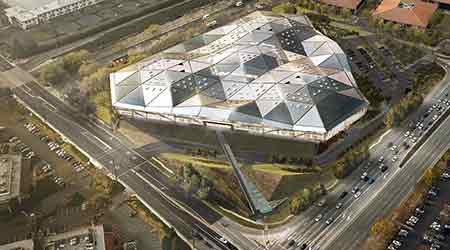 Bruce Thorpe, global lead, energy and critical environments, NVIDIA
Bruce Thorpe, global lead, energy and critical environments, NVIDIANVIDIA's New Facility: High-Tech FM
NVIDIA's new building "automates the building automation." An AI system learns and constantly tweaks the building for optimal efficiency.
The partnership between Thorpe and the product teams will get a stress test as the company moves to its new building this fall. That’s because the move portends a “significant change in our approach to critical environments,” says Thorpe. The current approach to these labs, says Thorpe, is that he builds out the space and then hands it over to the product team to manage. In the new building with new spaces, “we will maintain complete ownership,” says Thorpe. “We’re describing it as a mini-co-lo. We’ll have a service level agreement with KPIs we’ll both commit to, and we’ll manage the space on a day-to-day basis.”
Thorpe and his small group will maintain operational responsibility and ownership of the space, and will provide monthly reports on energy and other utility usage, among other metrics. “We’ll also point out where we think we can improve efficiencies,” he says, though making sure doing so doesn’t affect the purpose and use of the space. The idea is that this will help improve efficiencies because “right now, we don’t have insight into their space.”
Thorpe says this shift will be tough for the product teams, who are essentially relinquishing ownership of space. And that’s again why trust and partnership are so important. “It’s hard when the idea of control appears to be lost,” he says. “We’ll really have to build trust. We’ll have to be sure they know we’re not going to do anything that will impact what they want to do in the space. We’re actually here to help, but we have to prove that everyday.”
Beyond this cultural shift, the new building — which has been in discussion in some form or another since 2007 — also represents a technological shift in how it was designed, modeled, and will be operated. And it’s beyond cutting edge.
This starts with how the building was designed. It included modeling that was viewable with virtual reality devices. Thorpe casually mentions that he was in Shanghai on a business trip, but spent some time “walking through” the building’s electrical distribution rooms.

(NVIDIA's new building will include 259 skylights and a glass wall, and the company used its access to massive computing power to model every hour of every day in the year at every workspace to ensure that there would be no glare. Credit: Gensler.)
“We hope this will all mean reduced re-works,” says O’Brien. “Since we’ve done this modeling in virtual reality, we’ve seen this building in its completed fashion for four-and-a-half years.”
Thorpe is currently working with the commissioning team to ensure all building systems are functioning per design intent. As well, he’s working to ensure the documents are in order — though there are no paper documents for this building at all. “When there’s a change or an update, we’re layering that into our BIM model and the electronic document system, all of which is addressable from mobile devices.”
But here’s what’s really interesting about this building and its systems: When it’s up and running, this building will literally run itself.
“This building will be an AI laboratory for us,” says O’Brien. “Our CEO wants a building that can learn, integrate what it’s learned, and therefore be a truly smart building.”
Thorpe says the CEO’s directive for the building was along the lines of, “If my car can drive itself from San Francisco to New York and the human intervention is only to put gas in the tank, then why can’t my building run itself?”
So how will that work? Again, Thorpe talks about automating the automation with machine learning. “If somebody has to sit there and look at the BAS, then it’s not an automation system,” he says. “The building automation has to automatically look after itself.”
As one example of this, Thorpe has been working with a start-up tech company to put hundreds of sensors on cables to measure energy use. The company’s system doesn’t require a network inside the building – it only uses LTE, and then uploads data to the cloud. “Our GPU engine teaches it how to look at energy, and it samples energy 8,000 times per second,” says Thorpe. “Then it learns our profile and makes some smart suggestions.”
Thorpe says as he’s been going through the commissioning process with his agent, this system is already paying dividends. “It showed us that a motor had some problems — a motor had a broken rotor bar and was using too much energy,” he says. “Now the system knows what this looks like, and so it goes out to look for similar issues every second of every day, and reports back in a dashboard.”
A building’s learning curve
The suggestions the system provides can be incorporated or not — and as the system learns what a “yes” in a particular situation (“Do you want to turn this fan down sooner?”) means, it can apply that to other equipment throughout the building. If it’s a yes, the system will do it more.
“We think it’ll take about a year to learn, and when we’re confident it’s working, we’ll just let it go,” says Thorpe. “Technicians won’t be walking around looking for stuff, they’ll be reacting.”
Thorpe says he’s excited to get into the building and get the data to show that all these design ideas are working. Between the culture shift brought by ownership of the emulation labs and the building’s new machine learning technology, Thorpe says his role may change a bit in the new building.
Currently, he says if he walks fewer than six miles in a day, he probably had too many phone calls that day — he didn’t get out enough around the campus to talk with people in person. That in-person element with the product teams and IT will become even more critical in the new space. “I’ll spend a lot more time in client relationship management,” says Thorpe with a laugh. “I’ll be doing even more to understand their needs, what we can and can’t do, and how we can make things work for them.”
Email comments and questions to greg.zimmerman@tradepress.com.
Related Topics:















